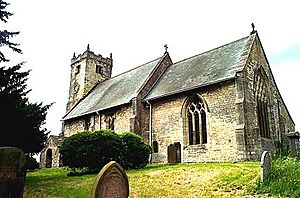Walton, Leeds facts for kids
Quick facts for kids Walton |
|
|---|---|
 St Peter's Church, Walton |
|
| Population | 225 (2001 census) |
| Civil parish |
|
| Metropolitan borough | |
| Metropolitan county | |
| Region | |
| Country | England |
| Sovereign state | United Kingdom |
| Post town | WETHERBY |
| Postcode district | LS23 |
| Dialling code | 01924 |
| EU Parliament | Yorkshire and the Humber |
Walton is a small village in West Yorkshire, England. It is located about 2 miles (3 kilometers) east of the town of Wetherby. Walton is very close to another village called Thorp Arch and the large business area known as Thorp Arch Trading Estate.
In 2011, about 225 people lived in Walton. The village is not on a main road and does not have many famous landmarks. Because of this, most people outside the Wetherby area do not know much about Walton.
What's in Walton?
Walton has one pub called The Fox and Hound. It recently had a fire. The village is also near the British Library building, which is very tall with eight floors. This building is part of the Thorp Arch Trading Estate.
The trading estate used to be a factory that made weapons for the government, called Royal Ordnance Factory, Thorp Arch. Today, it has many different businesses:
- The local council's recycling center (Leeds City Council)
- The British Library Boston Spa (a huge library)
- George Moores furniture factory
- A sewage treatment plant
- A retail park with shops like DFS and The Greenery Garden Centre.
You can find speed cameras on Walton Road, which is the road between Wetherby and Walton. These are the only speed cameras in this area. The village also has a small church.
Walton's History
The name Walton comes from an old English word. It means "settlement of the Wealas." The "Wealas" were the native Celtic people who lived in England before the Anglo-Saxons arrived.
There is good evidence that in many parts of England, the native British people stayed on their land even after Germanic-speaking settlers took over. Over time, these native people often started speaking the language of the newcomers. This helped them fit in or move up in society. The Anglo-Saxons wanted the native British to keep farming and producing goods. This helped the economy for the new landowners.
In the 1990s, there was a plan to build a new town in Walton. This plan was never put into action. However, the land is still available, and transport links in the area are even better now. So, the idea could still be considered in the future.
Walton was once on a railway line that went from Harrogate to Church Fenton. This railway line was removed in the 1960s as part of the Beeching Axe plan. Walton village never had its own train station. The closest one was in Thorp Arch. Today, it is easy to travel from Walton to the cities of Leeds and York.
Village Stories and Legends
Walton was once known for its "rag well." People believed the water from this well could cure eye problems. The well got its name because people would tie strips of cloth, or "rags," to a nearby tree as a reminder or offering.
A famous highwayman named Swift Nicks is said to have fallen asleep by the well one day. A group of local men came to arrest him. But Swift Nicks escaped by pointing a "burrtree gun," which was just a stick, at them. The men thought it was a real gun and got scared, running away like frightened cows. Because of this story, local men are sometimes called "Walton calves."

